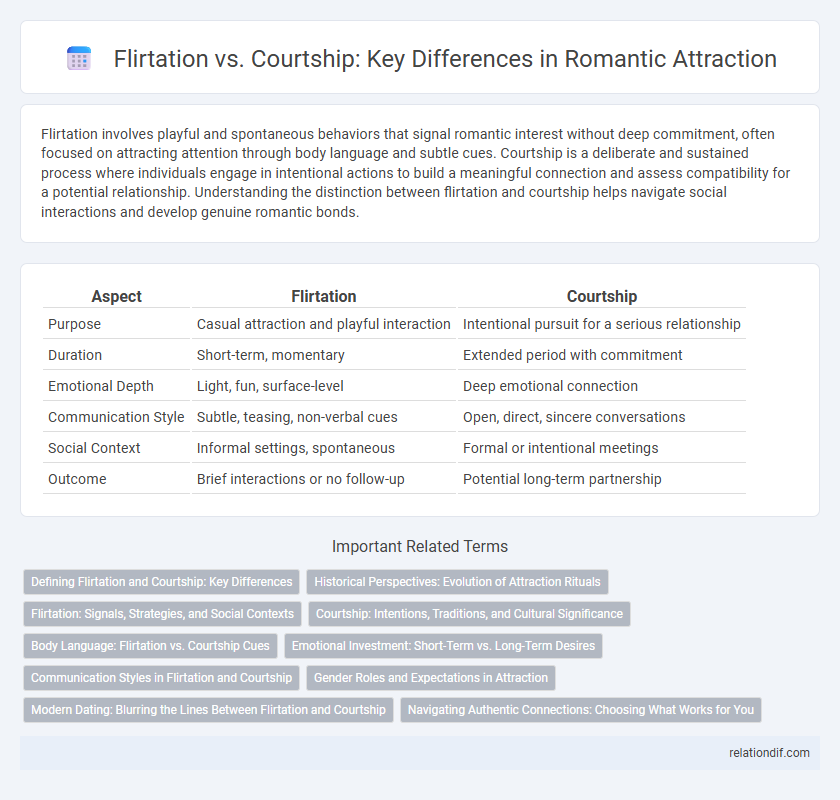Flirtation involves playful and spontaneous behaviors that signal romantic interest without deep commitment, often focused on attracting attention through body language and subtle cues. Courtship is a deliberate and sustained process where individuals engage in intentional actions to build a meaningful connection and assess compatibility for a potential relationship. Understanding the distinction between flirtation and courtship helps navigate social interactions and develop genuine romantic bonds.
Table of Comparison
| Aspect | Flirtation | Courtship |
|---|---|---|
| Purpose | Casual attraction and playful interaction | Intentional pursuit for a serious relationship |
| Duration | Short-term, momentary | Extended period with commitment |
| Emotional Depth | Light, fun, surface-level | Deep emotional connection |
| Communication Style | Subtle, teasing, non-verbal cues | Open, direct, sincere conversations |
| Social Context | Informal settings, spontaneous | Formal or intentional meetings |
| Outcome | Brief interactions or no follow-up | Potential long-term partnership |
Defining Flirtation and Courtship: Key Differences
Flirtation involves playful, often spontaneous interactions aimed at signaling romantic interest without explicit commitment, characterized by teasing, light touch, and flirtatious body language. Courtship is a deliberate, structured process of pursuing a romantic relationship with clear intentions of long-term commitment, often involving rituals, communication, and mutual agreement. Understanding these distinctions clarifies how flirtation functions as initial attraction activation, while courtship establishes deeper emotional bonds and relationship foundations.
Historical Perspectives: Evolution of Attraction Rituals
Flirtation and courtship have evolved significantly across historical eras, reflecting shifting societal values and gender roles in attraction rituals. Ancient civilizations like Greece and Rome emphasized public displays of flirtation for social networking, while Victorian courtship rituals prioritized formalized, chaperoned interactions designed to secure marriage alliances. Changes from communal to individualistic societies transformed these rituals, with modern dating practices blending flirtatious behaviors and courtship elements into more flexible expressions of romantic interest.
Flirtation: Signals, Strategies, and Social Contexts
Flirtation involves subtle signals such as prolonged eye contact, playful teasing, and light physical touch to indicate romantic interest without explicit commitment. Strategies include using body language and verbal cues to gauge attraction and create a sense of mutual intrigue, often performed in social settings like parties or casual gatherings. Understanding the social context is crucial, as flirtation norms vary by culture and environment, influencing how these signals are interpreted and reciprocated.
Courtship: Intentions, Traditions, and Cultural Significance
Courtship embodies deliberate intentions aimed at establishing a long-term relationship, often guided by cultural traditions and societal expectations. It involves respectful communication, mutual understanding, and rituals such as gift-giving or family involvement that reinforce commitment. Distinct from casual flirtation, courtship is deeply embedded in cultural significance, reflecting values about love, marriage, and social harmony.
Body Language: Flirtation vs. Courtship Cues
Flirtation body language is often subtle and playful, involving prolonged eye contact, light touches, and mirroring gestures to create a sense of attraction and intrigue. Courtship body language tends to be more deliberate and respectful, including open postures, gentle handholding, and attentive expressions that signal genuine interest and commitment. Recognizing the difference between these cues helps individuals interpret intentions accurately in social and romantic interactions.
Emotional Investment: Short-Term vs. Long-Term Desires
Flirtation typically involves light-hearted, short-term emotional investment aimed at immediate connection and playful interaction, often without expectations of deeper commitment. Courtship centers on long-term emotional investment, emphasizing building trust, understanding, and shared goals to develop a sustainable relationship. The distinction highlights the varying desires individuals pursue, where flirtation seeks momentary engagement and courtship fosters lasting emotional bonds.
Communication Styles in Flirtation and Courtship
Flirtation communication typically involves playful, subtle cues such as teasing, light touch, and suggestive body language aimed at sparking interest with minimal verbal exchange. Courtship communication emphasizes clear, intentional dialogue focused on expressing genuine intentions, values, and emotional compatibility to build a deeper connection. Both styles use nonverbal signals, but courtship prioritizes explicit conversations to establish commitment and mutual understanding.
Gender Roles and Expectations in Attraction
Flirtation often involves playful, spontaneous behavior where traditional gender roles can be more fluid, with both men and women engaging in teasing or subtle cues to signal interest. Courtship tends to follow established gender expectations, where men are usually expected to take the lead in pursuing and demonstrating commitment, while women may adopt a more receptive or evaluative role. These differing approaches reflect cultural norms that influence how attraction is expressed and negotiated between genders in social contexts.
Modern Dating: Blurring the Lines Between Flirtation and Courtship
In modern dating, the distinction between flirtation and courtship has become increasingly blurred, as digital communication encourages casual interactions that can quickly escalate into serious connections. Flirtation often serves as a playful, ambiguous signal of interest, while courtship reflects intentional efforts toward a committed relationship, but apps and social media platforms merge these behaviors in fluid, overlapping ways. This convergence challenges traditional dating scripts, making emotional expression and relationship progression more dynamic and less predictable.
Navigating Authentic Connections: Choosing What Works for You
Flirtation sparks initial interest through playful and spontaneous interactions, creating a lighthearted atmosphere that encourages genuine chemistry. Courtship involves intentional, deeper efforts to build trust and emotional intimacy over time, fostering meaningful connections rooted in shared values. Navigating authentic connections requires understanding your personal preferences and communication style to choose between the excitement of flirtation and the commitment of courtship, ensuring relationships align with your true desires.
Flirtation vs Courtship Infographic

 relationdif.com
relationdif.com